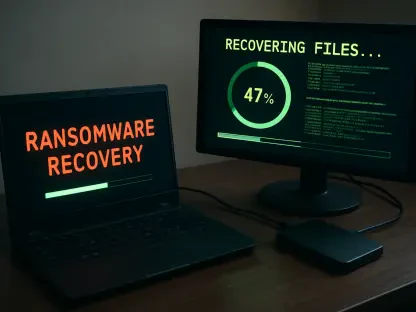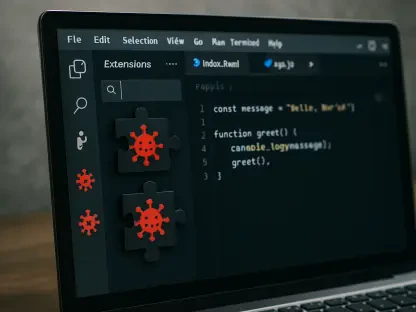What happens when a revolutionary tool designed to turbocharge software development ends up creating a maze of hidden dangers that threaten the stability of digital systems? In 2025, AI-powered code generation, once celebrated as the ultimate productivity booster, is now at the center of a heated debate within the tech industry. Developers are churning out code at unprecedented rates, but the cost is becoming alarmingly clear: insecure, bloated software that undermines the very foundation of digital infrastructure. This feature dives deep into the heart of this dilemma, uncovering why AI-generated code is sparking concern and what can be done to tame its wild side.
The Hidden Cost of Coding at Lightning Speed
The allure of AI in software development is undeniable. Tools powered by large language models (LLMs) have become indispensable, with adoption rates hovering between 84% and 97% among developers, according to Google’s DevOps Research and Assessment (DORA) report. The promise of a 17% boost in individual effectiveness has driven this rapid uptake. Yet, beneath the surface, a troubling reality emerges. The same report notes a nearly 10% rise in software delivery instability, while 60% of developers admit their teams face slower speeds or heightened instability. This stark contrast between expectation and outcome reveals a critical flaw: speed doesn’t always equal quality.
The significance of this issue cannot be overstated. As organizations—from nimble startups to sprawling enterprises—lean heavily on AI to meet tight deadlines, the risks of compromised security and unmanageable codebases grow exponentially. The tech world stands at a crossroads, grappling with how to balance the undeniable benefits of AI against the mounting technical debt it creates. This story isn’t just about a tool; it’s about the future of software reliability in an era where digital infrastructure underpins nearly every aspect of life.
A Flood of Code, a Drought of Quality
The sheer volume of code produced by AI tools is staggering. Analysis from GitClear, based on GitHub data, shows that the average developer now checks in 75% more code annually compared to just a few years ago. While this might seem like a win for productivity, it’s a double-edged sword. Much of this output is what experts call “code slop”—functional yet flawed software filled with redundant lines, unnecessary imports, and duplicated logic. Such bloat inflates maintenance costs and slows down systems, creating a burden that teams struggle to manage.
Security adds another layer of concern. Research from Veracode indicates that 45% of AI-generated code contains known vulnerabilities, a figure that has remained stubbornly high over recent years. This isn’t a minor glitch; it’s a systemic issue that amplifies as code volume grows. With developers unable to keep pace with reviewing these massive outputs, flaws slip through the cracks, embedding themselves in critical applications. The result is a ticking time bomb of potential breaches waiting to be exploited.
Voices from the Trenches: Experts Sound the Alarm
Industry leaders are not holding back on their warnings about AI’s impact on coding. Matt Makai, Vice President of Developer Relations at Digital Ocean, points out a chilling reality: “AI can replicate flaws across entire codebases if left unchecked, turning small oversights into sprawling technical debt.” His concern highlights how a single unvetted snippet can cascade into systemic problems, especially when speed trumps scrutiny.
Chris Wysopal, Chief Security Evangelist at Veracode, adds a sobering perspective: “Developers using AI often produce worse code than those who code manually. The quality gap hasn’t closed.” Meanwhile, Sarit Tager from Palo Alto Networks raises a deeper issue of accountability. “When developers don’t fully understand the AI-generated code they deploy, they lose the ability to spot errors or fix them,” Tager explains. These insights paint a unified picture—AI’s potential is immense, but blind reliance on its outputs is a recipe for disaster.
Real-World Fallout: When AI Code Goes Wrong
The consequences of unchecked AI code are not theoretical; they’re playing out in real time. Consider a mid-sized fintech company that adopted AI tools to accelerate app development. Initially, the results were impressive—features rolled out weeks ahead of schedule. But within months, the team discovered critical security flaws in the AI-generated authentication module, exposing sensitive user data. The fix required a complete overhaul, costing more in time and resources than the initial gains had saved.
Such cases are becoming all too common. Another example involves a gaming studio that used AI to generate backend scripts. The output was riddled with redundant code, causing server lag that frustrated players and tanked user ratings. These stories underscore a harsh truth: without rigorous oversight, AI can transform from a productivity ally into a costly liability, impacting not just budgets but also brand trust and user safety.
Charting a Safer Path: Strategies to Rein in AI Risks
Addressing the challenges of AI-generated code demands practical, actionable solutions. One approach is to shift focus from mere generation to curation. Teams should be trained to critically evaluate AI outputs, treating them as rough drafts rather than final products. As Makai suggests, developers can practice “vibe engineering” by prompting AI not only for code but also for security audits and optimization ideas, turning the tool into a collaborative partner.
Automated safeguards offer another line of defense. Integrating vulnerability scanners and efficiency checkers early in the development cycle can catch issues before they spiral. Drawing from the Google DORA report, high-performing teams—dubbed “Pragmatic Performers”—provide a model to emulate. These groups balance speed and stability through structured workflows, proving that discipline can coexist with innovation. Cultivating a culture of ownership, where developers dive into the logic behind AI code, further reduces long-term risks, ensuring that human judgment remains the final arbiter.
Looking Back, Moving Forward
Reflecting on the journey through 2025, the tech community wrestled with the dual nature of AI-generated code—a tool of immense promise shadowed by significant peril. The struggle to balance productivity with quality shaped countless projects, as bloated codebases and security gaps tested the resilience of even the most adept teams. Lessons emerged from every misstep, painting a clearer picture of what worked and what faltered.
Moving ahead, the path was paved with opportunity for those willing to adapt. Investing in robust training to empower developers with critical assessment skills stood out as a priority. Building automated safety nets into workflows promised to catch flaws before they spread. Above all, fostering a mindset of accountability ensured that AI remained a tool, not a crutch. The road forward demanded vigilance, but with these steps, the industry could harness AI’s power while safeguarding the integrity of the digital world.









